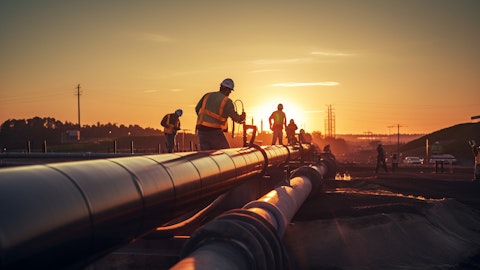Operator: Our next question is coming from Neil Mehta from Goldman Sachs. Your line is now live.
Neil Mehta: Congrats on the improvement in capital efficiency and the guide. Just a macro question. I guess the first one is on propane. Can you talk a little bit about Slide 5 and what do you think has been the main driver of getting the inventories back to the five year. And as we think about propane markets, Asia continues to be really important and sometimes harder for us as an investment community to get visibility out there. So talk about how you think about China and Asia feeds into the propane ounces of 2024.
Justin Fowler: Yes, I think there a couple of things I’ll talk about on the propane inventory level. I mean, one, there was a surprise adjustment from the EIA. They had — really since mid-November, through, call it, mid to late December. They had a calculation error, so they were overstating propane inventories. So we got an initial nice bump there but better late than never and then as we moved into January, we continue to see the exports stay strong all of December and January, and we started to get some cold weather. We maybe had a call it, 1.5 weeks of cold weather, resulted in some production losses as well at the same time that demand was strong domestically and the export docks weren’t affected. So I think that’s what you see in that chart there is the December adjustment as well as a couple of good weeks of data in January.
And now we’re just seeing things trend very much in line with the five-year average. And so if that continues, we would expect to be call it, down to the 45 million to, call it, 48 million-barrel range at the end of withdrawal season. So I think that moving from the top of the five-year range to the five-year average, I think took the narrative from some of the barrels — propane stocks were in dire circumstances. We didn’t see that ourselves and pleased to see it play out the way that it ultimately did. On the international question, we used to have a slide in here that talked about propane going to China where it showed absolute demand kind of moving steadily up into the right, but utilization moving lower as they added big chunks of PDH capacity.
And that’s what we’ve seen happen. PDH utilization rates are down in the 60% to 65% range. Petchem margins in the East are low, which isn’t surprising given all the capacity that has come online. But overall, absolute demand has continued to move up. And so again, we remain optimistic that with that amount of capacity in place, ready to be ramped up, should things improve economically, in particular, in China, they’ve not had things bounced back post COVID reopening as many of us thought they would. We think there’s a lot of upside there, whether or not the U.S. will be able to supply it all instantaneously, I think is a function of if the Gulf Coast stocks can expand in time. We think of that call for demand is here in 2024. They probably won’t be able to get all of it from the U.S., but we’ll certainly benefit being out of the East Coast with our capacity.
So that’s the things we look at the most. There is ResComm demand growing globally. That’s certainly stickier, harder to give you visibility on that. It’s more — over time, looking at things coming out of individual countries talking about initiatives or expansions of import terminals. But the big obvious things have been the Petchem expansions and those are real. They’ve resulted in higher demand despite the lower utilization rate just because they’ve turned on so much capacity.
Neil Mehta: Yes. That’s really helpful. And then on the dry gas side, recognize your more liquid storage that you might have the most objective view on this, but we’ve been really surprised at U.S. production. It’s great showing it month to date, close to 105 with 2Bs up in the Permian and 2Bs in Appalachia. What do you make of that? And do you believe this data and to the extent that U.S. production is surprising the upside, what’s driving it? And how does it resolve its side?
Michael Kennedy: Yes. We haven’t surprised — we had slides out there thinking that after the 9 to 12 months kind of time period from when the rigs really started to drop last May, you’d start to see a response in production that’s historically kind of the time frame that’s required to work through that high rig count level. You haven’t seen that yet. You actually saw the opposite. So that has been surprising to us. We’re hoping that it’s kind of one last push in gas production. You do historically see the rise in Appalachian gas during the winter months because that’s when there’s demand and then it falls off kind of heading into the shoulder season. So hopefully, that occurs and then you continue to see lower rig counts in the Permian and oil windows.
So hopefully, that had some effect. But that’s kind of the question, 105 Bcf market, it’s not really a 105 Bcf market. So you’ll see some shut-ins, either from lower activity levels or lower gas production from lower activity levels or shut-in during the shoulder season the balance of the market. So time will tell whether that 105 Bcf holds.
Operator: Next question is coming from David Deckelbaum from TD Cowen. Your line is now live.
David Deckelbaum: I just wanted to touch on — good to hear from me guys. I wanted to just bring up the NGL growth into ’24. And obviously, maybe there’s some benefits on the ethane side. So I wonder if you could give a little bit of color on just the breakdown of what’s driving that NGL growth because obviously, you’re directing a little bit more activity to the NGL heavy corridor, but you’re still looks like overall, completing around 10% fewer lateral feet this year. So is this a well-performance situation? Or is this really some of the incremental contribution from the ethane processing side?
Michael Kennedy: No. As we said, we’re really just flat. I mean when you kind of look at it, David, I think we’re up 2%. That’s just continued focus in the 1,275 to 1,300 Btu corridors that continues to be more and more of our well count those type of wells. Your gas declining, I mean that’s kind of the more of the story is we’re allowing that gas to decline 3% but growing the liquids a little bit, that maintenance capital calculation. But you’ve kind of seen that last year when we grew in ’23, it was really NGL growth. We grew 14% on the liquids and gas was only up 2%. So it’s kind of just a natural outcome of really focusing on the 1,300 Btu type liquid wells and just letting the natural gas, the drier areas of our field decline.
David Deckelbaum: I appreciate that. I guess if there was a scenario where you were to get back to three rigs and two completion crews at some point in the future, would that inherently lead to just a greater gas mix in the portfolio? Or should we be thinking about the mix that you’re looking at in ’24?
Michael Kennedy: Not initially. We got the liquid inventory day for 10 years, after 10 years, yes, it would be dry gas. But for the next 10 years, this is a good kind of mix where we’re at. So the three rigs, it was kind of similar outcomes to last year where you grow the liquids and probably the double-digit rains but the gas is flat.
David Deckelbaum: I appreciate that. And if I could just sneak one in. Just the reduced land budget this year, is that intentional restraint? Or is it just more limited opportunity after you guys were very successful there last year?
Michael Kennedy: No. I mean it’s also a result of our completion efficiencies and development of — when you have less wells that you’re drilling each year, that maintenance capital decreases, like we said, it was down to $50 million this year. And last year, it was at $75 million to $100 million. So you do have a big land component where you’re trying for the next two years’ time, call it, really build up those working interest, build up the NRI, really focusing on that. So when you have less wells in that two-year period, you have less land. And then it’s not the — we are the consolidator of the liquids fairway in West Virginia. So it’s very hard for anyone to come in and capture those locations other than us. We have the midstream like we said we have — it’s very contiguous.
It’s small in — we’re just going right next door and leasing these locations. So we’re the natural consolidator. So those opportunities aren’t less. It’s just we have less wells over the next two years when you only running a few rigs and one completion crew.
Operator: Next question is coming from Kevin MacCurdy from Pickering Energy. Your line is now live.
Kevin MacCurdy: Congratulations on the well-received 2024 guidance. I just have one question, and it’s kind of a follow-up to the gas macro question that was asked earlier. In your opinion, how do you think the gas markets get solved? Do you have an opinion of where or who will be shutting in gas production or where the production declines will come from?
Michael Kennedy: What should come from across all natural gas stations because at today’s strip, I don’t think there’s many natural gas plays that are economic. You have to have liquids like we have to make any sort of economics in today’s gas price environment. So I would say any basin that doesn’t have liquids and also where there’s a substantial basis and there’s no real takeaway. So that’s pretty much all natural gas stations right now probably should have less activity. So I think that will naturally occur because economics at the end of the day always went out. So I think that will occur. I think the liquids plays will continue to see activity. But if it’s a dry natural gas play that’s constrained, it’s most likely going to have lower activity.
And plus, as we go into shoulder season and whatever, you always see kind of economics dictating some shut-ins. So that 105 Bcf although on a spot day to day, seems like it’s there. Over time, you’ll see some occasional events or occasional events that will decrease that.
Operator: We reached the end of our question-and-answer session. I’d like to turn the floor back over to Brendan for any further closing comments.
Brendan Krueger: Yes. Thank you for joining us on today’s call. Please reach out with any further questions. Thank you.
Operator: Thank you. That does conclude today’s teleconference and webcast. You may disconnect your line at this time, and have a wonderful day. We thank you for your participation today.





